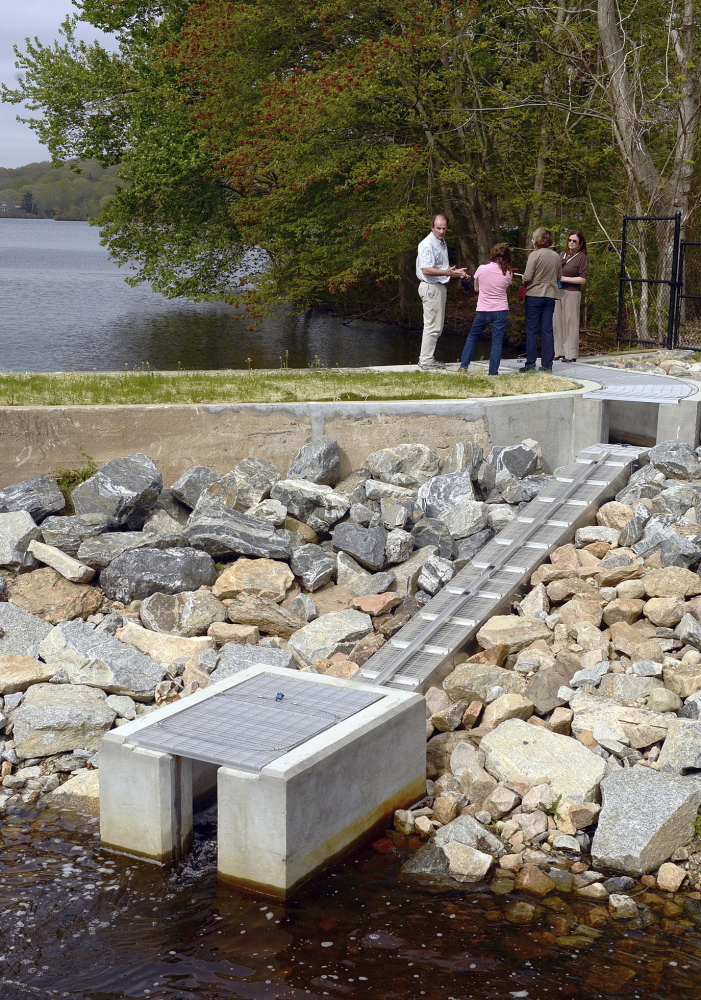OLD LYME, Conn. — Everything’s ready for migratory alewives to return to Rogers Lake in Old Lyme for the first time in several hundred years – the gleaming new concrete-and-steel fish ladder’s open, the water’s flowing through it and the electronic fish counter is poised to start clicking away.
Now it’s up to the fish to find their way there.
“I think it’s just a matter of time,” Steve Gephard, head of the Inland Fisheries Division of the state Department of Energy and Environmental Protection, said Thursday as he crouched next to the 20-foot ladder beside the chamber housing the counter.
His confidence comes from watching the success of other fish ladders and dam removal projects across the state at restoring migratory fish runs. Typically, he said, it takes a few years after a ladder opens before alewife, blueback herring and shad start returning en masse. Those successes, along with the ecological importance of anadromous fish – those that divide their time between fresh and salt water environments – will be highlighted Saturday during World Fish Migration Day, a first-ever international event.
DEEP and The Nature Conservancy are sponsoring 16 events across Connecticut. Worldwide, 49 countries are hosting 257 events, including 66 in the United States, according to Pao Fernández Garrido, spokeswoman for the event and staff member at a Dutch water resources consulting firm, Wanningen Water Consult, that is one of the event’s founding organizations.
The event has its origins in a Fish Migration Day first celebrated in the Netherlands in 2003, she said. This evolved into Living North Sea Fish Migration Day in 2011. The purpose of the event is to build appreciation for what’s been done to remove obstacles to migrating fish, and support for tackling the challenges that lie ahead.
“If we’re going to succeed at getting more dams removed and more fish ladders built,” she said, “we’re going to have to have more people aware. We’ve had tremendous results. Every time we reopen a habitat, we see an increase in the runs.”
Built as part of a $330,000 project to restore the concrete dam at the lake, the ladder opened in time for the annual spring migration of river herring – the collective term for alewives and blueback herring – into freshwater streams, lakes and ponds to spawn, after spending the winter hundreds of miles away in marine waters. The project was the result of a partnership between the town, DEEP and the Connecticut River Watershed Council, paid for mainly with federal, state and private grants.
No river herring swam up the Mill River through the new ladder this spring during the migration weeks – a result, Gephard believes, of a lackluster year for river herring returning through two fishways on the Mill River below the Rogers Lake ladder. The herring that did come through, he said, probably found plenty of spawning habitat in Lower Mill Pond and Mill Pond, but in a future year with a strong run, they’ll find their way up the new ladder to Rogers Lake.
The lake was one of the many historic spawning areas blocked off by dams built first by European colonists and then by successive generations that are now being reopened with dam removal and fish ladder projects.
Send questions/comments to the editors.



Success. Please wait for the page to reload. If the page does not reload within 5 seconds, please refresh the page.
Enter your email and password to access comments.
Hi, to comment on stories you must . This profile is in addition to your subscription and website login.
Already have a commenting profile? .
Invalid username/password.
Please check your email to confirm and complete your registration.
Only subscribers are eligible to post comments. Please subscribe or login first for digital access. Here’s why.
Use the form below to reset your password. When you've submitted your account email, we will send an email with a reset code.